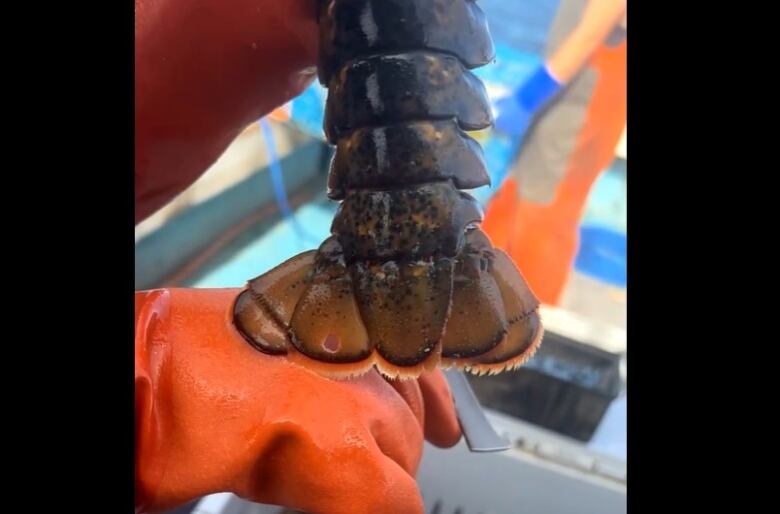Sipekne'katik fisherman's protest dumping of lobster 'not acceptable,' chief says
In the video, fisher objectsto a new federal compliance measure that marks the tail fins with a hole
A Sipekne'katik First Nation fisherman who appears in a video posted to Facebook showing him dumping crates of banded lobstersinto Digby harbour has been rebuked by the band'schief.
In the video, Robert Syliboyobjectsto a new Department of Fisheries and Oceans (DFO) compliance measure that marks the tail fins of lobster with a paper hole puncher. The holepunchaims to identify lobsters harvested underIndigenous food, social and ceremonial (FSC) licenses in St Mary's Bay.
The conditions of those licensesprevent the sale of the catch.
In the video,Syliboy says DFOis harming the lobsters by punching holes in their tail fins.
"They are now taking every single lobster out of our traps and they are hole punching the tail flaps so we cannot take them to market," he says in the video.

"They're dying so fast that our load we have here now can't even get home so we have to throw them at the closest wharf."
Syliboy and another man then dump several crates of lobster over the side of the Digby wharf.
Many, if not all, ofthe lobsters still have rubber bands on their claws, which preventuse of the claws for feeding or defence.

Protest dumping 'unacceptable'
Sipekne'katik Chief Mike Sack issued a statement to CBCNews in response to the video.
"That practice is not acceptable within our fishery's practices and our department is addressing it with the fisher directly," he said in the statement.
"We expect our fishers to adhere to the highest principles of conservation and protection possible and through our ongoing training and planning, compliance will always be a key aspect of our fisheries management plan."
DFO also looking into video
Chief Sack was not alone in picking up on the video.
"DFOconservation andprotection is aware of this video and is taking the appropriate investigative steps," spokesperson Lauren Sankey said in a statement to CBC News.
She said FSC licences require discarded lobster to be returned to the sea with as little damage possible.
"As this matter is part of an ongoing investigation, no further details will be provided at this time."
Chief backs claim hole punch is harmful
Chief Sack isunhappy with the way the catch was discardedin the video, but agrees with Syliboy's claim that hole punching harms lobsters.
"This practice is not proven to be safe or humane and sadly we now have proof that it is detrimental to the lobster with the mortality rates witnessed in our fishers' catch," he said in the statement to CBC News.
"The through-and-through hole punching promotes bacteria, infection and weakens the lobster - this unfortunately has resulted in some fishers forfeiting and returning their catch to the ocean," he said.
13,000 lobsters marked in October
DFO says 13,000 lobsters have been marked using a paper hole puncher since the pilot project was introduced in St. Marys Bay this month to protect "the integrity of the FSC fishery."
Fishery officers haul traps, mark the lobster andput themback in the trap which is returned to the water.
DFO says it simplifies inspections. The department said it is not aware of any evidence that physical marking of tails jeopardizes the health of the lobster.
It likens hole punching to the practice of notching tails with a V-shape, which has been used in Maine for decades to identify breeding females which cannot be landed.

A view from Maine
Studies in 1995 and 2000 have shown the number of V-notched female lobsters increasing in Maine, says Chris Cash,a spokesman for theLobster Institute at the University of Maine.
"So I feel like those statistics alone show the success and the viability of V-notching and not causing or showing any significant damage to lobsters," says Cash, a former commercial lobster fisherman.
"It has been our greatest conservation method."
Director and scientist Robert Wahlealso issued a statement on the practice.
"Can I say without doubt that notching a tail does not elevate the risk of infection or disease? No," he said in the statement.
"But I suspect that the rationale behind the approach is that the benefits to reproductive performance outweigh the risks."













_(720p).jpg)


 OFFICIAL HD MUSIC VIDEO.jpg)
.jpg)



























































































